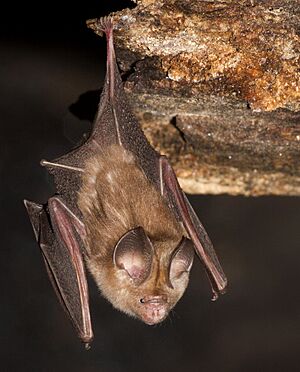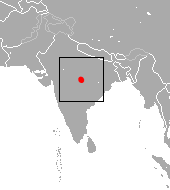Khajuria's leaf-nosed bat facts for kids
Quick facts for kids Khajuria's leaf-nosed bat |
|
|---|---|
 |
|
| Conservation status | |
| Scientific classification | |
| Genus: |
Hipposideros
|
| Species: |
durgadasi
|
 |
|
| Khajuria's leaf-nosed bat range | |
| Synonyms | |
|
Hipposideros cineraceus durgadasi |
|
The Khajuria's leaf-nosed bat, also called Durga Das's leaf-nosed bat, is a special kind of bat. Its scientific name is Hipposideros durgadasi. This bat lives only in India and makes its home in caves. Sadly, it is facing danger because its habitat (where it lives) is shrinking.
Contents
What is the Khajuria's Leaf-Nosed Bat?
The Khajuria's leaf-nosed bat is a unique species of bat. It belongs to the family called Hipposideridae. These bats are known for their interesting nose shapes.
How Was This Bat Discovered?
Scientists first thought this bat was a type of H. cineraceus. But later, in 1975, a scientist named Topál realized it was a completely different species. The first bat of this kind was found in 1970. It was discovered in the Jabalpur district of Madhya Pradesh, India.
What Does the Khajuria's Leaf-Nosed Bat Look Like?
This bat has soft fur that can be brown or reddish-brown on its back. Its belly is usually whitish. Like some other bats in its group, it does not have extra skin folds on its nose.
Special Nose Features
The front part of its nose has a dip in the middle. It is covered with short, stiff black hairs. The part between its nostrils is well-formed. It has a short base and a round, bulb-like top. The nostrils themselves are oval. They have small flaps on their outer edges.
Tail and Other Unique Traits
The bat's tail sticks out past the skin between its legs. Scientists can tell this bat apart from similar species by its unique nose shape. Also, its tail sticking out and a special C-shaped bone (called a baculum) help identify it.
What Does the Khajuria's Leaf-Nosed Bat Eat?
This bat is an insectivore, meaning it eats insects. Its diet includes beetles, crickets, and other small insects.
How Does the Bat Find Food?
The Khajuria's leaf-nosed bat uses echolocation to find its way and hunt. This means it sends out very high-pitched sounds. These sounds bounce off objects and return to the bat. By listening to the echoes, the bat creates a sound map of its surroundings. It echolocates at a very high frequency, between 168.4 and 175.7 kHz. This is much higher than some other similar bat species.
Where Does the Khajuria's Leaf-Nosed Bat Live?
This bat lives only in India. It has been found in specific villages in the Jabalpur district of Madhya Pradesh. It also lives in the Kolar district of Karnataka. In 1998, a group of scientists found more of these bats in the Mirzapur district of Uttar Pradesh.
Where Do They Roost?
Khajuria's leaf-nosed bats live in colonies, which are groups of several bats. They often roost (rest) in cave systems. They can also be found under large granite rocks. Sometimes, they share their roosts with other bat species. Other times, they stay only with bats of their own kind.
Where Do They Hunt?
These bats mostly hunt for food in dry tropical forests. They also forage in areas with tropical thorn forests.
Why is the Khajuria's Leaf-Nosed Bat Endangered?
The IUCN lists this bat as vulnerable. This means it is at risk of becoming endangered or extinct. There are a few reasons for this:
- It lives in a very small area.
- Its population is spread out and small.
- The number of bats is still going down.
- Its habitat is constantly being damaged.
Main Threats to the Bat
The biggest danger to the bat is habitat loss. This is caused by stone quarrying operations. Quarrying is when people dig up rocks and stones from the ground. In the Kolar district, illegal granite mining happens very close to where the bats live. This mining threatens their roosting caves. The bats also face danger from people disturbing their roosts.
What is Being Done to Help?
Currently, there are no specific laws or agreements to protect this bat. Also, the places where the bat lives are not part of any protected areas. Scientists need to do more studies to find out exactly where these bats live. This is because some populations might be mistaken for other similar bat species. Knowing their true range will help protect them better.


